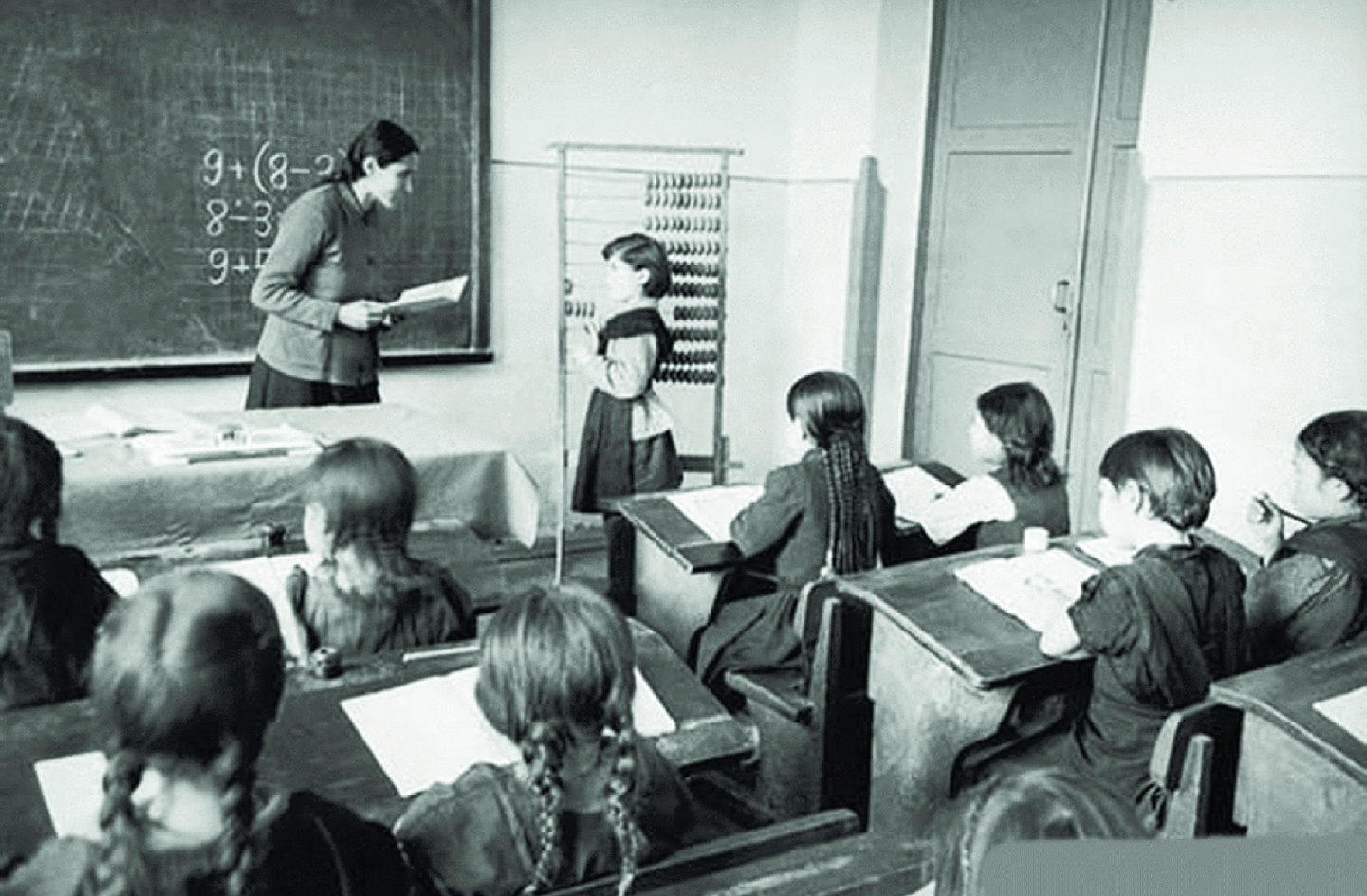Is this a new twist? From pedagogy to andragogy, from andragogy to hutagogy
Those who work with information technology have to study continuously. But adults cannot learn by the same principles as schoolchildren: our ability to perceive information changes throughout life. Research in this area has led to the emergence of a new educational concept, and the information boom, the spread of mobile Internet devices and the development of social networks have determined the next shift in the educational paradigm.
In this article I will tell you how educational concepts have evolved, on what principles of adult education modern training centers rely on, and what will change in education in the near future.

Education is considered one of the most conservative areas of human activity. However, in the theory of learning, great changes occur from time to time. One of these changes happened in the middle of the last century: a separate section of the theory of education took shape - adult education, or “andragogy”.
The need to “pump” into adult minds a large amount of complex technical information in a short time inevitably led to the study of the characteristics of an adult as a subject of the learning process. One of the first examples of such a task is the training of soldiers during the Second World War. A relatively recent example is the training of IT professionals.
We all know the traditional school and university approach to learning. This training is mainly content-oriented, and the teacher is at the center of the educational process. He is an indisputable authority.

A source
The approach is focused on mass education of a group of students more or less homogeneous in the initial level of knowledge and experience. Often students have no experience, and their mind is a “blank, white sheet of paper." At least 20 students are usually involved in school classes, and in lectures at universities, the number of students can exceed a hundred. Programs in schools and universities are multi-year and primarily focused on obtaining fundamental knowledge. And, more importantly, the school and the university should teach the younger generation to consciously learn and work.
What is the difference between the approach to learning within the framework of andragogy ?

Source
If we talk about the training of IT specialists, then every self-respecting IT vendor has a program of training and certification (exams) of teachers, which is based on the principles of andragogy, and training centers conducting such training programs must have trained teachers on staff.

A source
These postulates were adopted by training centers in the field of information technology. A network of such institutions, mainly commercial ones, developed in Russia by the beginning of this century.
But gradually the situation in education again began to change qualitatively. This is due to several factors.

A source
Thus, at the beginning of this century, the theory of a new approach to learning began to take shape, which was called "huytagogika" (eutagogy).
The term “hutagogy” or “eutagogy” (two equivalent translations of English heutagogy) was formulated in a scientific article by Australian educators and scientists Stewart Hase and Chris Kenyon in 2000. This term, by analogy with "pedagogy" and "andragogy" is constructed from Greek words that appeal to independent search, discoveries and conclusions.

The source of
Hyutagogic is not opposed to andragogy and does not cancel it, but is its continuation, the next step in which the student takes on the role of a leader in the educational process. He not only independently searches and selects information, but also chooses teaching methods and methods. This means that the student should be aware of the nature of such options and evaluate their effectiveness.
The role of the teacher is also changing. It is best to describe his mission with the foreign term “facilitator” (a person who provides successful group communication). He monitors compliance with the rules of the meeting, its procedures and regulations. The facilitator allows its participants to concentrate on the goals and content of the meeting.
To implement the principles of hutagogy in the educational process, approaches to the production of educational content should be studied, revised and adjusted. Obviously, it should be as clear as possible, served using game components and, preferably, in small portions in different formats.
Now the effectiveness of self-study is one of the main topics when discussing corporate training issues. This is due to the fact that in all large organizations (including our group of companies), e-learning systems have already been introduced, which, as a rule, imply self-study as the main form of education.
At the same time, everyone understands that the conversion of those who began to study independently and those who completed this training without additional organizational and methodological efforts is small. Self-study should be “fueled” by the external energy of experts, tutors, motivators, and other listeners. The presentation form and accessibility of the material, the duration of the educational unit - everything makes sense and significance, otherwise the interest in self-study is lost.
A number of personnel training specialists note the general low culture of self-education in Russia. Using the elements of self-education at the courses of the Network Academy, we also often note that specialists are not ready for the perception of proactive forms of independent learning. For example, students cannot critically perceive information and ask questions to the teacher, but are more focused on the traditional approach, when the teacher asks questions about the material studied. It can be difficult for students to independently control the quality of assimilation of the material. That is, it is not easy for an adult brought up with a traditional education system and accustomed to a passive perception of new information to adapt to a new system.

A source
Therefore, it is better to change approaches to learning from childhood, at school or even earlier. It is very important to teach people to study independently and consciously, because properly built independent training can compete in effectiveness with online learning.
Many companies are experimenting with self-learning methodology and motivating students, intuitively using the provisions of huytagogika. Learning approaches and training practices such as micro-learning, sms-training, mobile learning, blended learning, etc. We also conduct experiments and introduce practices and tools that have proven to be effective (for example, the so-called “personal training”). At the same time, we understand in hindsight that basically all the innovations that we introduce are related to the approach in the spirit of hutagogics.
For example, we change the role of the teacher, making him more of a consultant, guiding the self-education of students, rather than a lecturer, or give more freedom to students in choosing material for study. But it is always better to understand the general principles of building training than to use the “scientific poke” method.
At one time, the study of the principles of andragogy helped us a lot in building mass education for adult students. I don’t know whether conscious attempts were made in Russia to build self-directed learning (if there are such examples, please share). In the world such studies were carried out, for example, training graduate students in project management at the University of Hull .
Changes in approaches to corporate training (and, probably, in education in general) are coming, and they are inevitable and are already taking place. Business needs specialists who can make independent decisions and bring them to the result. The ability to direct one's self-study, of course, correlates with such a business requirement.

Source
So far, a new concept of adult education is at the stage of comprehension, generation of ideas, trial and error. We are waiting for changes and preparing for them. Do you notice how the approaches to education have changed in recent decades?
Below is a small survey on this topic, and we think everyone will be interested to know how Habr’s readers study.
In this article I will tell you how educational concepts have evolved, on what principles of adult education modern training centers rely on, and what will change in education in the near future.

Education is considered one of the most conservative areas of human activity. However, in the theory of learning, great changes occur from time to time. One of these changes happened in the middle of the last century: a separate section of the theory of education took shape - adult education, or “andragogy”.
Although the term “andragogy” was introduced by the German historian-teacher Alexander Kapp a hundred years earlier, in the 19th century, the theory of adult education was not really developed until the middle of the 20th century.
The need to “pump” into adult minds a large amount of complex technical information in a short time inevitably led to the study of the characteristics of an adult as a subject of the learning process. One of the first examples of such a task is the training of soldiers during the Second World War. A relatively recent example is the training of IT professionals.
We all know the traditional school and university approach to learning. This training is mainly content-oriented, and the teacher is at the center of the educational process. He is an indisputable authority.

A source
The approach is focused on mass education of a group of students more or less homogeneous in the initial level of knowledge and experience. Often students have no experience, and their mind is a “blank, white sheet of paper." At least 20 students are usually involved in school classes, and in lectures at universities, the number of students can exceed a hundred. Programs in schools and universities are multi-year and primarily focused on obtaining fundamental knowledge. And, more importantly, the school and the university should teach the younger generation to consciously learn and work.
What is the difference between the approach to learning within the framework of andragogy ?
- Most importantly, adult students have accumulated baggage , experience. This experience should be considered in the learning process. If you ignore the students' existing experience, learning becomes ineffective and meaningless. Moreover, the experience of different listeners varies significantly. Often, teachers have to "fight" with prevailing stereotypes.
- The role of the teacher is changing significantly . This is no longer an indisputable authority, but a "mere mortal." The teacher is not above the student body, but inside. He is a guide, an organizer, his task is to lead his group into a "bright future". Listeners are equal participants in their group and can influence the direction of movement. An authoritarian, team style of teaching is unacceptable.

Source
If we talk about the training of IT specialists, then every self-respecting IT vendor has a program of training and certification (exams) of teachers, which is based on the principles of andragogy, and training centers conducting such training programs must have trained teachers on staff.
In our training center "LANIT Network Academy" we always cautiously hire already existing school teachers and university professors. Not each of them succeeds in overcoming their usual views on the learning process and in restructuring.

A source
- Students can have very different learning motivations , and this must be taken into account. Without a personal approach to each listener in this situation can not do.
- Adult education is usually short-term and intensive . You can’t stretch the program so as not to take specialists away from their work duties for a long time. In our training center, usually the duration of the courses is 5 days, 8 academic hours each.
Since training in information technology is applied in nature, the content of courses quickly becomes obsolete. Now the usual term for updating technical IT courses is no more than two years.
- To ensure the effectiveness of training that follows the principles of andragogy, the number of students in the group should be small, in the region of 10 people.
These postulates were adopted by training centers in the field of information technology. A network of such institutions, mainly commercial ones, developed in Russia by the beginning of this century.
But gradually the situation in education again began to change qualitatively. This is due to several factors.
- The procedure for publishing information has become very simple and accessible for everyone, and the speed of dissemination of information is almost instant. This happened due to the development of the Internet, search engines and social networks.
- The use of electronic gadgets connected to high-speed mobile networks has become widespread - first of all, we are talking about smartphones and tablets. This factor has changed not only approaches to the development and distribution of software, but also increased the availability of educational content. Now, in fact, any person can get access to educational materials at any time and from anywhere in the world and even space.

A source
- The development of computer technology and data transmission backbone networks now allows you to store and quickly transfer huge arrays of complex data . Educational content from a predominantly text-graphic has become for the most part multimedia-interactive.
- E-learning (elearning), as well as simple tools for the preparation of electronic educational materials have become a given, a reality today.
Thus, at the beginning of this century, the theory of a new approach to learning began to take shape, which was called "huytagogika" (eutagogy).
Elearning actively talked about e-learning in the 90s of the last century, which was associated with the growing availability of personal computers and the development of the Internet. Then in the West there were schools with distance learning for students from distant settlements. Today, the use of e-learning is a common practice not only for schools and universities, but also for business.
The term “hutagogy” or “eutagogy” (two equivalent translations of English heutagogy) was formulated in a scientific article by Australian educators and scientists Stewart Hase and Chris Kenyon in 2000. This term, by analogy with "pedagogy" and "andragogy" is constructed from Greek words that appeal to independent search, discoveries and conclusions.

The source of
Hyutagogic is not opposed to andragogy and does not cancel it, but is its continuation, the next step in which the student takes on the role of a leader in the educational process. He not only independently searches and selects information, but also chooses teaching methods and methods. This means that the student should be aware of the nature of such options and evaluate their effectiveness.
Hytagogogy is a creative approach to self-study, which will allow the student to determine what, when and how he will study.
The role of the teacher is also changing. It is best to describe his mission with the foreign term “facilitator” (a person who provides successful group communication). He monitors compliance with the rules of the meeting, its procedures and regulations. The facilitator allows its participants to concentrate on the goals and content of the meeting.
To implement the principles of hutagogy in the educational process, approaches to the production of educational content should be studied, revised and adjusted. Obviously, it should be as clear as possible, served using game components and, preferably, in small portions in different formats.
Now the effectiveness of self-study is one of the main topics when discussing corporate training issues. This is due to the fact that in all large organizations (including our group of companies), e-learning systems have already been introduced, which, as a rule, imply self-study as the main form of education.
At the same time, everyone understands that the conversion of those who began to study independently and those who completed this training without additional organizational and methodological efforts is small. Self-study should be “fueled” by the external energy of experts, tutors, motivators, and other listeners. The presentation form and accessibility of the material, the duration of the educational unit - everything makes sense and significance, otherwise the interest in self-study is lost.
A number of personnel training specialists note the general low culture of self-education in Russia. Using the elements of self-education at the courses of the Network Academy, we also often note that specialists are not ready for the perception of proactive forms of independent learning. For example, students cannot critically perceive information and ask questions to the teacher, but are more focused on the traditional approach, when the teacher asks questions about the material studied. It can be difficult for students to independently control the quality of assimilation of the material. That is, it is not easy for an adult brought up with a traditional education system and accustomed to a passive perception of new information to adapt to a new system.

A source
Therefore, it is better to change approaches to learning from childhood, at school or even earlier. It is very important to teach people to study independently and consciously, because properly built independent training can compete in effectiveness with online learning.
Many companies are experimenting with self-learning methodology and motivating students, intuitively using the provisions of huytagogika. Learning approaches and training practices such as micro-learning, sms-training, mobile learning, blended learning, etc. We also conduct experiments and introduce practices and tools that have proven to be effective (for example, the so-called “personal training”). At the same time, we understand in hindsight that basically all the innovations that we introduce are related to the approach in the spirit of hutagogics.
For example, we change the role of the teacher, making him more of a consultant, guiding the self-education of students, rather than a lecturer, or give more freedom to students in choosing material for study. But it is always better to understand the general principles of building training than to use the “scientific poke” method.
At one time, the study of the principles of andragogy helped us a lot in building mass education for adult students. I don’t know whether conscious attempts were made in Russia to build self-directed learning (if there are such examples, please share). In the world such studies were carried out, for example, training graduate students in project management at the University of Hull .
Changes in approaches to corporate training (and, probably, in education in general) are coming, and they are inevitable and are already taking place. Business needs specialists who can make independent decisions and bring them to the result. The ability to direct one's self-study, of course, correlates with such a business requirement.

Source
So far, a new concept of adult education is at the stage of comprehension, generation of ideas, trial and error. We are waiting for changes and preparing for them. Do you notice how the approaches to education have changed in recent decades?
Below is a small survey on this topic, and we think everyone will be interested to know how Habr’s readers study.
Only registered users can participate in the survey. Please come in.
What form of training do you consider the most successful for yourself?
- 21.7% Full time in a group 27
- 14.5% Individual Learning 18
- 2.4% Distance Learning 3
- 39.5% Self-study 49
- 0.8% Mobile Learning 1
- 2.4% Micro-Learning 3
- 15.3% Mentoring 19
- 3.2% Own answer option (I will write in the comment) 4
Have you participated in corporate employee training programs?
- 27.6% Yes, it helped me in my work 31
- 27.6% Yes, but it actually gave me nothing 31
- 39.2% No, did not participate 44
- 5.3% No, but I'm going to study at the company 6
Are you ready to spend your money on training?
- 75.4% Ready 83
- 23.6% I need to invest 26
- 0.9% My answer (I will write in the comment) 1
What is the most important learning outcome for you?
- 58.6% Knowledge 71
- 41.3% Professional Growth 50
- 0% Certificate 0
Which gadget helps you learn?
- 83.7% Computer 98
- 4.2% Phone 5
- 8.5% Tablet 10
- 3.4% Custom answer (I will write in the comments) 4
